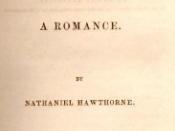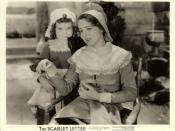The Scarlet Letter as a Method of Understanding Characters
In The Scarlet Letter, Hawthorne uses his characters' reactions to the scarlet letter to illustrate society's influence on the beliefs of individuals. Generally, the individual will adopt the beliefs of those around him, but if a person is mistreated by, or separated from, the community, this tendency can be curtailed. The typical Bostonian treats the scarlet letter simply as a symbol of shame to be acknowledged with disdain, ensuring the effectiveness of the punishment. In contrast, Hester, Pearl, and Dimmesdale all react to the scarlet letter in different ways, reflecting their connection to Puritan Boston.
Hester defiantly endures her punishment, almost to the point of being proud of her adultery and the mark it has left on her. She serves her penance dutifully, but nonetheless exudes a subtle aura of rebelliousness, stealing all satisfaction from the townspeople. One of her most clever methods of maintaining dignity is to decorate the scarlet letter, giving it "â¦all the effect of a last and fitting decoration to the apparel which she woreâ¦" (50).
Instead of wearing a utilitarian mark of shame, Hester transforms the letter into a fashionable work of art. By highlighting the letter through embroidery, an art that has always come naturally to Hester, and stoically refusing to remove it, she shows that the scarlet letter does not change who she is. Humiliated and shunned by the community, Hester no longer has any regard for the laws of the colony. Part of her willingness to mock her punishment comes from her deep roots in England. Even as she stands on the scaffold, the first stage of her punishment, she thinks of her home: "Standing on that miserable eminence, she saw again her native village, in Old England, and her paternal home; a decayed house of gray stone, with a poverty-stricken aspect, but retaining a half-obliterated shield of arms over the portal, in token of antique gentility." (54). A clear parallel is drawn between Hester and her childhood home: they are both worn down, but each bears a mark of nobility and dignity. Hester's religious link to the society obligates her to serve her penance, but her lack of personal connection to the Bostonians causes her subtle resistance.
While Hester has a basic plan and moral foundation for coping with the effects of the scarlet letter, Pearl does not know what to think of it, other than that her mother has always worn it. Therefore, the townspeople's adverse reaction to it confuses her. This is just one example of Pearl's incompatibility with mainstream Bostonian society. In the same way that Hester clings to her homeland of England, Pearl reflects the nature of her origin: the sinful union of Hester and the Reverend Mister Dimmesdale. Just as she was conceived in a moment of untamed passion, Pearl is a wild child, completely at odds with the rigid structure of Puritan custom. Her defiance of Puritan social values is not tempered by maturity as is her mother's. When the "little Puritans" follow her and whisper behind her back, she turns on them and chases them away with shrieks and thrown rocks. Pearl is beyond all control, even her mother's, so much so that she refuses to help herself: when Hester tries to convince the governor of her good influence on Pearl by asking her daughter to recite the catechism for Mr. Wilson, she cannot answer the first question, even though Hester has taught her the proper responses. From birth, Pearl has been raised outside of society: "â¦its existence, heretofore, had brought it acquainted only with the gray twilight of a dungeon, or other darksome apartment of the prison." (49-50). Spending her first days of life in the most unwelcoming place Boston has to offer, Pearl is greatly disillusioned with Puritanism, and society in general. Hester tries to help Pearl to be more attuned to society by teaching her the catechism, but to no avail: the impact of society's treatment of Pearl cannot be overcome.
Hester and Pearl are outcasts, but because of his deep and powerful bond to Puritan society and his guilty conscience, the Reverend Mr. Dimmesdale has difficulty rationalizing the scarlet letter. Dimmesdale is the most important figure in the institution that guides the lives of all Bostonians: the church. His coupling with Hester presents a profound contradiction in his mind: he must maintain an image of purity so that his congregants do not lose faith at their minister's sin, but at the same time, his love for Hester demands a public confession. Chillingworth's mental torture hurts Dimmesdale, but most of the minister's pain comes from internal forces. Chillingworth would never have suspected that Dimmesdale was Pearl's father had he not displayed his guilt so openly in his health and manner. "'I need no medicine,' said he. But how could the minister say so, when, with every passing Sabbath, his cheek was paler and thinner, and his voice more tremulous than before,-when it had now become a constant habit, rather than a casual gesture, to press his hand over his heart?" (107). Although Dimmesdale is severely damaged by Chillingworth's insidious ministrations, he has already suffered from the polarizing effects of religion and love. Chillingworth was only a catalyst: it was society's pull against his love for Hester that destroyed him.
Hawthorne's use of the scarlet letter to highlight society's influence on the individual reveals the dangerous potential and the fundamental flaw of Puritan society: Puritan beliefs state that any sin, regardless of the severity, condemns a person's soul forever. This means that the society will judge and label a person's character based on a single incident. Giving powerful significance to artificial labels can easily lead to more general and malicious prejudices. The weakness of the system is caused by the varying interpretations of events by different people. Hawthorne uses the scarlet letter to support this theory: the scarlet letter "A" originally means "adulterer", but once Hester has carved out a niche as an embroiderer and a charitable person and established herself as a contributor to society, its meaning changes to "able". While 17th Century Boston is generally a conformist society, the dynamism and uniqueness of the individual interprets the meanings of events to suit what it believes to be true or right, a tendency that challenges the power of rigid Puritan scripture.
Works Cited
Hawthorne, Nathaniel. The Scarlet Letter. New York: Penguin Books, 2003.





